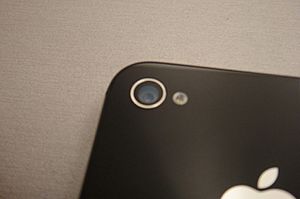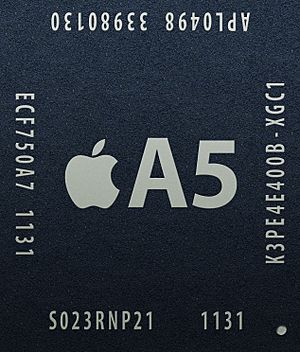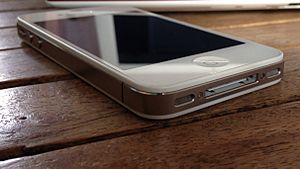- This page was last modified on 9 February 2024, at 09:09. Suggest an edit.
iPhone 4s facts for kids
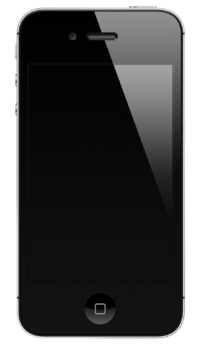
Black iPhone 4s
|
|
| Brand | Apple Inc. |
|---|---|
| Manufacturer | Foxconn & Pegatron (contract manufacturers) |
| Slogan | "The most amazing iPhone yet" |
| Generation | 5th |
| Model | A1431 (GSM China Model) A1387 |
| Compatible networks | GSM, CDMA, 3G, 3G+, HSUPA |
| First released | October 14, 2011 |
| Availability by country |
October 14, 2011
Germany
Canada France United States Japan Australia United Kingdom Egypt October 28, 2011
Austria
Belgium Czech Republic Denmark Estonia Finland Hungary Ireland Italy Latvia Liechtenstein Lithuania Luxembourg Mexico Netherlands Norway Singapore Slovakia Slovenia Spain Sweden Saudi Arabia Sudan & Eritrea November 11, 2011
Albania
Armenia Bulgaria El Salvador Greece Guatemala Hong Kong South Korea Malta Montenegro New Zealand Panama Poland Portugal Romania United States (non-contract) November 25, 2011
Colombia
Moldova India Croatia December 16, 2011
Brazil
Chile Malaysia Philippines Russia Saudi Arabia South Africa Taiwan Thailand Turkey United Arab Emirates Vietnam Kuwait Bahrain Israel January 13, 2012
Anguilla
Antigua and Barbuda Bolivia Botswana British Virgin Islands Cameroon Cayman Islands Central African Republic China Dominica Dominican Republic Ecuador Grenada Guam Guinea Conakry Ivory Coast Jamaica Kenya Madagascar Mali Mauritius Niger Senegal St. Vincent and The Grenadines Trinidad and Tobago Turks and Caicos Uganda Jordan Venezuela Lebanon January 27, 2012
Costa Rica
Indonesia |
| Discontinued | September 20, 2012 (32, 64 GB) September 10, 2013 (16 GB) September 9, 2014 (8 GB) February 17, 2016 (India) |
| Units sold | Four million in first three days of initial sales (October 14–17, 2011) 60+ million total |
| Model before | iPhone 4 |
| Replacement model | iPhone 5 |
| Related | iPod Touch (5th generation) |
| Type | Smartphone |
| Form factor | Slate |
| Size | 115.2 mm (4.54 in) H 58.6 mm (2.31 in) W 9.3 mm (0.37 in) D |
| Weight | 140 g (4.9 oz) |
| Operating system | Original: iOS 5.0 Last: iOS 9.3.6, July 22, 2019 |
| System on chip | Dual-core Apple A5 |
| CPU | 1.0 GHz (Underclocked to 800 MHz) dual-core 32-bit ARM Cortex-A9 |
| GPU | PowerVR SGX543MP2 |
| Memory | 512 MB DDR2 RAM |
| Storage | 8, 16, 32, or 64 GB |
| Battery | 3.7 V, 5.3 Whr (~1430 mAh) Lithium-ion battery |
| Data inputs | Multi-touch touchscreen display Dual microphone 3-axis gyroscope 3-axis accelerometer Digital compass Proximity sensor Ambient light sensor |
| Screen | 3.5 in (89 mm) diagonal 3:2 aspect ratio widescreen LED backlit IPS TFT LCD 960×640 Resolution at 326 ppi 800:1 contrast ratio (typical) 500 cd/m2 max. brightness (typical) Fingerprint-resistant oleophobic coating on front and back glass |
| Rear camera | Sony Exmor R IMX145 8 MP back-side illuminated sensor HD video (1080p) at 30 frame/s IR filter Aperture f/2.4 5 element lens Image signal processor (built-in A5) Face detection (stills only) image stabilization |
| Front camera | 0.3 MP VGA (480p) |
| Sound | Single loudspeaker 3.5 mm TRRS, 20 Hz to 20 kHz frequency response (internal, headset) 3.5mm audio jack Microphone |
| Connectivity | Wi-Fi (802.11 b/g/n) (2.4 GHz only) Bluetooth 4.0 Combined GSM/CDMA antenna: quad-band GSM/GPRS/EDGE (800 850 900 1,800 1,900 MHz) Quad-band UMTS/HSDPA/HSUPA (800 850 900 1,900 2,100 MHz) (800 MHz unannounced) Dual-band CDMA/EV-DO Rev. A (800 1,900 MHz) GLONASS, Global Positioning System (GPS) |
| SAR | Head: 1.18 W/kg Body: 1.19 W/kg |
The iPhone 4s is a smartphone that was designed and marketed by Apple Inc. It is the fifth generation of the iPhone, succeeding the iPhone 4 and preceding the iPhone 5. It was announced on October 4, 2011, at Apple's Cupertino campus, and was the final Apple product announced in the lifetime of former Apple CEO and co-founder Steve Jobs, who died the following day.
Orders could be placed on October 7, 2011, and mainstream availability in retail stores began on October 14, 2011 in the United States, Australia, Canada, the United Kingdom, France, Germany, and Japan. Sales peaked over its predecessor with more than a million sales in the first twenty-four hours of order availability and more than four million sales in the first four days of retail availability. Further worldwide rollout, including 22 additional countries on October 28, came during the next several months.
This iPhone was named "4s" where the "s" stood for Siri, an intelligent personal assistant that was initially exclusive to the 4s and later included in future Apple products. Retaining most of the external design of the iPhone 4, the 4s hosted major internal upgrades, including an upgrade to the Apple A5 chipset, and an 8-megapixel camera with 1080p video recording. It debuted with iOS 5, the fifth major version of iOS, Apple's mobile operating system, that introduced features including iCloud, iMessage, Notification Center, Reminders, and Twitter integration.
Reception to the iPhone 4s was favorable. Reviewers noted Siri, the new camera, and processing speeds as significant advantages over the prior model. It was succeeded by the iPhone 5 as Apple's flagship smartphone on September 12, 2012. The 16 GB iPhone 4s remained on sale at a reduced price point, with the 32 and 64 GB models discontinued. The 16 GB 4s was also subsequently discontinued in September 2013 with the release of the iPhone 5C and iPhone 5S and replaced with the 8 GB model which was offered free on contract in the United States.
The 4s was officially discontinued on September 9, 2014 following the announcement of the iPhone 6, although production did continue for developing markets until February 17, 2016. During the course of its lifetime, the iPhone 4s was one of the best-selling iPhones ever produced and it is the first iPhone to support five major versions of iOS: iOS 5, iOS 6, iOS 7, iOS 8, and iOS 9 (the iPad 2 was supported from iOS 4 to iOS 9).
The 4s is the last iPhone to have Apple’s proprietary 30 pin connector, as the succeeding iPhone 5 replaced it with the all digital Lightning connector.
Origin
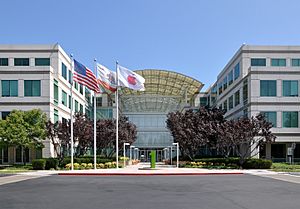
The "Let's Talk iPhone" event was held at the Apple Campus, instead of the Yerba Buena Center for the Arts, where most non-WWDC events are held.
As early as May 2011, some leaks had a fairly accurate description of the iPhone 4s including the name "iPhone 4s", the Apple A5 chip, HSDPA, new camera, and Sprint carrying.
The iPhone 4s was unveiled at Apple's "Let's Talk iPhone" event on October 4, 2011, on the Apple Campus in Cupertino, California. The keynote was the first which Tim Cook gave since the Verizon keynote earlier in the year. It was also Cook's first launch without Apple co-founder Steve Jobs, whose health was deteriorating, and he died the day after the announcement of the iPhone 4s. Tim Carmody of Wired praised Cook for focusing on company achievements, calling him a "global business thinker" and a "taskmaster".
At the "Let's Talk iPhone" event held by Apple on October 4, 2011, Mike Capps demonstrated Epic Games' Infinity Blade II, the sequel to Infinity Blade, on an iPhone 4s. Capps boasted that the game uses Epic Games' Unreal Engine 3 and features the same graphic techniques used in the Xbox 360 game Gears of War 3.
Speculation about Apple's next generation smartphone, including various specifications and a predicted name "iPhone 5", had been widespread in the time preceding its debut. After the iPhone 4s was announced, it was considered by some media to be a disappointment, due to the expected release of an iPhone 5.
There were no external differences between the iPhone 4 CDMA model and the iPhone 4s, with the exception of a SIM card slot on the iPhone 4s. All changes were internal (slight external differences between the iPhone 4 GSM model and the iPhone 4s exist, as said differences existed between the CDMA and GSM models of the iPhone 4).
On September 10, 2013, the iPhone 4s name was re-stylised as iPhone 4s, using a lower case 's' to reflect the names of the newly announced iPhone 5s and iPhone 5c. This was unusual for Apple as an upper case 'S' had been used since the introduction of the iPhone 3GS in 2009.
On September 9, 2014, the iPhone 4s was officially discontinued following the reveal of iPhone 6 and iPhone 6 Plus. However, 4s production did continue for developing markets until February 17, 2016.
On September 13, 2016, following the release of iOS 10, Apple dropped support for the iPhone 4s, making iOS 9 the last major iOS version available for the device.
| Release dates | |||||
|---|---|---|---|---|---|
| October 14, 2011 | October 28, 2011 | November 11, 2011 | November 25, 2011 | December 16, 2011 | January 13, 2012 |
| Australia Canada France Germany Japan United Kingdom United States |
Austria Belgium Czech Republic Denmark Estonia Finland Hungary Ireland Italy Latvia Liechtenstein Lithuania Luxembourg Mexico Netherlands Norway Singapore Slovakia Slovenia Spain Sweden Switzerland |
Albania Armenia Bulgaria El Salvador Greece Guatemala Hong Kong Malta Montenegro New Zealand Panama Poland Portugal Romania South Korea (non-contract) |
Colombia Croatia India Moldova |
Bahrain Brazil Chile Israel Kuwait Malaysia Philippines Russia Saudi Arabia South Africa Taiwan Thailand Turkey United Arab Emirates |
Anguilla Antigua and Barbuda Bolivia Botswana British Virgin Islands Cameroon Cayman Islands Central African Republic China Dominica Dominican Republic Ecuador Grenada Guam Guinea Ivory Coast Jamaica Jordan Kenya Lebanon Madagascar Mali Mauritius Niger Senegal St. Vincent and The Grenadines Trinidad and Tobago Turks and Caicos Uganda Venezuela |
Software
For more details, see iOS version history
The iPhone 4s, like other iPhones, runs iOS, Apple's mobile operating system. The user interface of iOS is based on the concept of direct manipulation, using multi-touch gestures. Interface control elements consist of sliders, switches, and buttons. The response to user input is immediate and provides a fluid interface. Interaction with the OS includes gestures such as swipe, tap, pinch, and reverse pinch, all of which have specific definitions within the context of the iOS operating system and its multi-touch interface.
Internal accelerometers are used by some applications to respond to shaking the device (one common result is the undo command) or rotating it in three dimensions (one common result is switching from portrait to landscape mode).
The iPhone 4s was first shipped with iOS 5.0, which was released on October 12, 2011, two days before the release of the device. As of April 2021, the device can be updated to iOS 9.
It can act as a hotspot, sharing its internet connection over WiFi, Bluetooth, or USB, and also accesses the App Store, a digital application distribution platform for iOS developed and maintained by Apple. The service allows users to browse and download applications from the iTunes Store that were developed with Xcode and the iOS SDK and were published through Apple.
The iPhone 4s can play music, movies, television shows, ebooks, audiobooks, and podcasts and can sort its media library by songs, artists, albums, videos, playlists, genres, composers, podcasts, audiobooks, and compilations. Options are always presented alphabetically, except in playlists, which retain their order from iTunes. The iPhone 4s uses a large font that allows users plenty of room to touch their selection. Users can rotate their device horizontally to landscape mode to access Cover Flow. Like on iTunes, this feature shows the different album covers in a scroll-through its photograph library. Scrolling is achieved by swiping a finger across the screen. Alternatively, headset controls can be used to pause, play, skip, and repeat tracks. On the 4s, the volume can be changed with the included Apple Earphones, and the Voice Control feature can be used to identify a track, play songs in a playlist or by a specific artist, or create a Genius playlist.
The iPhone 4s introduced a new automated voice control system called Siri, that allows the user to give the iPhone commands, which it can execute and respond to. For example, iPhone commands such as "What is the weather going to be like?" will generate a response such as "The weather is to be cloudy and rainy and drop to 54 degrees today." These commands can vary greatly and control almost every application of the smartphone. The commands given do not have to be specific and can be used with natural language. Siri can be accessed by holding down the home button for a short amount of time (compared to using the regular function). An impact of Siri, as shown by Apple video messages, is that it is much easier for people to use device functions while driving, exercising, or when they have their hands full. It also means people with trouble reading, seeing, or typing can access the smartphone more easily.
On the iPhone 4s, texting can be aided by the voice assistant, which allows speech-to-text. In addition to regular texting, messaging on the iPhone 4s is supported by iMessage, a specialized instant messaging program and service that allows unlimited texting to other Apple iOS 5 products. This supports the inclusion of media in text messages, integration with the device's voice-controlled software assistant, and read receipts for sent messages. Input to the computer comes from a keyboard displayed on the multi-touch screen or by voice-to-text by speaking into the microphone. Entered text is supported by predictive and suggestion software as well as a spell-checker, that includes many regional dialects such as Swiss spoken French.
At the announcement, plans were in place for the iPhone 4s to support many languages. Different features have different language requirements, such as keyboards compared to the word predictor and spell-checker, which needs a large dictionary of words. Language support is related to the iOS 5 operating system that the device launched with, although not always. The Siri digital assistant supported French, English, and German at launch. Since it uses a software-based keyboard supported by the multi-touch display, it can support many different keyboard layouts without having to change physically. The iPhone 4s can display different languages and scripts at the same time.
On September 19, 2012, iOS 6 was released to the iPhone 4s among other compatible iOS devices as an over the air (OTA) upgrade package. According to Apple the update contained 200 new features and tweaks, which included a new maps app, dubbed Apple Maps, Facebook integration and Passbook, an application that allows users to store their coupons, boarding passes, and tickets digitally. On September 18, 2013, Apple released iOS 7 and the iPhone 4s is among other compatible iOS devices that also received the update without any lagging issues compared to the iPhone 4. Although the device improved performance over iOS 7, some newer features that were released to newer models such as AirDrop and CarPlay were not supported. The iPhone 4s can also run iOS 8, which was released on September 17, 2014. Given that the device was supported for more than three years, some newer features of the software such as Apple Pay were not supported. It is also unable to work with Apple Watch, due to the relatively aged hardware. In fact, some users often reported that performance on the 4s is very slow, similar to how iOS 7 ran on the iPhone 4, and suggesting that they should not upgrade due to battery draining issues and hanging up on calls. Meanwhile, Apple released iOS 8.1.1, which brought slight improvements to the phone and the iPad 2, but it still did not run so fast as newer models.
Hardware
The iPhone 4s uses the Apple A5 system-on-chip (SoC), also found in the iPad Mini (1st generation), that incorporates an Imagination Technologies PowerVR SGX543 graphics processing unit (GPU). This GPU features pixel, vertex, and geometry shader hardware supporting OpenGL ES 2.0. The SGX543 is an improved version of the GPU used in the iPhone 4s predecessor, the iPhone 4. The iPhone 4s uses a dual-core model that is integrated with the Apple A5 SoC in the same way as the iPad 2. Apple claims that the iPhone 4s has up to seven times faster graphics than the iPhone 4; this was corroborated by Epic Games president Mike Capps.
The iPhone 4s has 512 MB of DDR2 RAM. Maximum available storage size increased to 64 GB while the 32 GB and 16 GB model options were retained. In September 2013 Apple released an iPhone 4s for free with a two-year contract, but with only 8 GB of storage. The screen is the same as the prior generation iPhones; 3.5 inches (89 mm), 640×960 resolution (Apple's "retina" design). There was an improvement in interactive multimedia applications compared to its predecessor.
The iPhone 4s has an improved cellular (GSM) antenna design over the iPhone 4. The new antenna is divided up into two pieces within the stainless steel band that wraps around the sides of the smartphone. Therefore, if the iPhone 4s is gripped in such a way as to attenuate one piece of the cellular antenna, the radio will switch to the other piece that isn't being gripped. The iPhone 4s can support a maximum theoretical download speed of up to 14.4 Mbps with HSDPA+. As a result of an upgraded radio chip inside it, in addition to being a world phone, both GSM and CDMA customers can roam internationally on GSM networks. It also supports Bluetooth 4.0.
The camera on the iPhone 4s, also known as an iSight camera, can take 8-megapixel photographs (3,264 by 2,448 pixels) and record 1080p videos at up to 30 frames per second with upgraded quality (30% better clarity, 26% better white balance, color accuracy) due to an additional lens, IR filter, a wider f/2.4 aperture, and Image signal processor (built-in A5).
The built-in gyroscope allows for some image stabilization for the camera while recording video, although it still has room for improvement, since state-of-the-art image stabilization algorithms do not need to use a gyroscope, but use image processing. Other features of the camera are macro (for close up pictures) and faster capture including being able to take its first image in 1.1 seconds and the next half a second later.
The iPhone 4s features a 3.5 in (89 millimetres) 960 by 640 pixel multitouch Retina display. It has two volume buttons and a ring-silent switch on the left side. On the top left there is a 3.5 mm headphone jack and a microphone that is used for both noise cancellation during calls and when in speakerphone/FaceTime (video calling) mode. The lock-power button is situated on the top right edge of the device. The right side of the device has a Micro-SIM card slot. The bottom of the device features a speaker output on the right and a microphone input on the left with the Apple proprietary 30-pin dock connector in the center. The iPhone 4s supports video out via AirPlay and various Apple A/V cables. Supported video formats include H.264 (1080p 30 frames per second maximum), MPEG-4 video, and motion JPEG (M-JPEG).
In addition to user inputs, the device also has several sensors that give the smartphone information about its orientation and external conditions. These include a three-axis gyroscope, an accelerometer, a proximity sensor, and an ambient light sensor. The iPhone 4s claimed to have 200 hours standby time, 8 hours talk time on 3G, 14 hours talk time on 2G, 6 hours 3G browsing, and 9 hours Wi-Fi browsing. Additionally, it can sustain up to 10 hours of video playback or 40 hours of audio playback.
Design
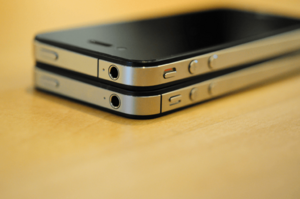
Comparison of the iPhone 4 (GSM) antenna placement (top) with that of the iPhone 4s (bottom). Notice the repositioning of the antennas that forms the perimeter around the smartphone; the iPhone 4 antenna is on the top of it while on the iPhone 4s, the antennas are on the sides. This side antenna placement meant a benefit of cellular signal attenuation and was used in later models such as the iPhone 5.
The iPhone 4s has a stainless steel, dual cellular antenna design, identical to iPhone 4 CDMA. Apple redesigned the antenna in the iPhone 4 CDMA after some original iPhone 4 users reported cellular signal attenuation problems as a result of holding it in certain positions. The improved cellular radio in the smartphone can switch between two antennas, depending on which is sending/receiving the best signal. These two antennas are incorporated into the distinctive stainless steel band that wraps around the sides of the iPhone 4s. The bands on the iPhone 4s are divided into two antennas: cellular and Global Positioning System GPS, with Bluetooth and Wi-Fi reliant on an internal antenna.
The iPhone 4 and 4s were designed by Jonathan Ive. The '4' generation iPhones differ from earlier Apple designs; the bulges of the back panel as well as the band between the front and back are gone and have been replaced with flattened surfaces. The redesign reflects the utilitarianism and uniformity of existing Apple products, such as the iPad and the iMac. The overall dimensions of the iPhone 4s are lower than that of the 3GS.
It is 115 millimetres (4.5 in) high, 59 millimetres (2.3 in) wide, and 9.4 millimetres (0.37 in) deep, compared to the iPhone 3GS, which is 116 millimetres (4.6 in) high, 62 millimetres (2.4 in) wide, and 12 millimetres (0.47 in) deep; making the iPhone 4 and 4s 21.5% thinner than the 3GS. The internal components are situated between two panels of aluminosilicate glass, described by Apple as being "chemically strengthened to be 20 times stiffer and 30 times harder than plastic," theoretically allowing it to be more scratch-resistant and durable than the prior models.
See also
 In Spanish: IPhone 4s para niños
In Spanish: IPhone 4s para niños
- Comparison of smartphones
- List of iPhone models
- Timeline of iPhone models


